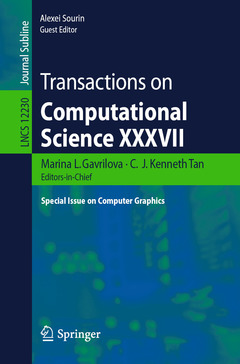Description
Transactions on Computational Science XXXVII, 1st ed. 2020
Special Issue on Computer Graphics
Transactions on Computational Science Series
Coordinators: Gavrilova Marina L., Tan C. J. Kenneth, Chang Jian, Thalmann Nadia Magnenat
Language: English
Keywords
artificial intelligence; augmented reality; communication systems; computer hardware; computer networks; computer systems; computer vision; data communication systems; Human-Computer Interaction (HCI); image analysis; image processing; interactive computer graphics; internet; machine learning; pattern recognition; signal processing; telecommunication systems; user interfaces; virtual reality; wireless telecommunication systems
171 p. · 15.5x23.5 cm · Paperback
Description
/li>Contents
/li>Comment
/li>
Do Distant or Colocated Audiences Affect User Activity in VR?.- Polarization for Coherent Augmented Reality Scene on Mobile Devices.- Integrated Analysis and Hypothesis Testing for Complex Spatio-temporal Data.- Action Sequencing in VR: A No-Code Approach.- Single Color Sketch-Based Image Retrieval in HSV Color Space.- Integral-Based Material Point Method and Peridynamics Model for Animating Elastoplastic Material.- A Perceptually Coherent TMO for Visualization of 360° HDR Images on HMD.- Simulating Crowds and Autonomous Vehicles.- MagiPlay: An Augmented Reality Serious Game Allowing Children to Program Intelligent Environments
Focuses on a wide range of computer graphics applications
Topics range from crowd simulation and autonomous vehicles to a serious game allowing children to program intelligent environments
Includes a paper on the use of a deep learning method for the analysis of bird song




